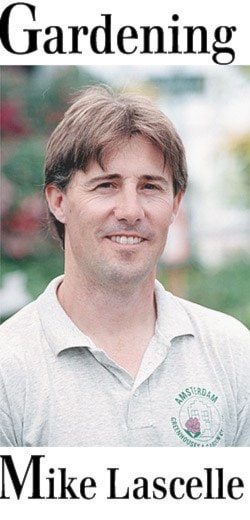The simple act of planting a tomato is something that many of us take for granted.
We just assume that if we are willing to put it in the ground, that it somehow owes us a bountiful crop.
Sadly enough, there are a lot of disappointed people out there, and if you have ever used those pasty, bland, juice-abandoned tomatoes that the supermarkets are so fond of selling, you know exactly what I’m talking about.
So I’d like to introduce you to someone who takes his tomato growing seriously, to the tune of about 200 pounds a year – all of which is either dried, made into sauce or eaten fresh by Erwin Gygli and his family, who live in Pitt Meadows.
Erwin is a grower by profession and his business, Heimat Farm, specializes in herbs, edible crops and exotic plants sold to garden centres and direct to public at the Trout Lake Farmer’s Market in Vancouver.
His appreciation of gardening and of edibles, in particular, comes in part from his love of cooking, because sooner or later you realize that it’s the fresh ingredients that make the meal.
As a result, he and his wife Sharon have an extensive kitchen garden, chock full of seasonal produce, and Erwin has graciously agreed to share a few of his tomato-growing secrets with us.
• Soil preparation: Erwin believes that if you want good tasting tomatoes, you are going to have to take some time preparing the soil. Tomatoes are heavy feeders and they need good drainage, so he recommends raised planters and adding liberal amounts of compost (he prefers leaf mould), as well as dolomite lime, bone and blood meal (follow the label rate) to the soil. The dolomite lime raises the pH and provides calcium, preventing blossom end rot (a common deficiency problem).
• Types of tomatoes: tomatoes come in two basic growth forms: determinate and indeterminate – or to put it in layman’s terms, bush and vining. Erwin keeps vining types to a single stem, which he stakes high, as these plants continue producing right up until the frosts – the suckers should also be removed.
For determinate types he prefers young plants with two strong branches diverging from a single stem. He plants these to just below the fork. You can use a tomato cage to support bush types, and Erwin only allows about seven fruit trusses to develop, pinching out the rest. This increases the size and quality of the tomatoes.
• Planting tomatoes: tomatoes are heat-loving plants and most people plant them outdoors too early – so Erwin recommends the Victoria Day May long-weekend as a good rule of thumb. Because tomatoes are capable of developing roots anywhere along the stem, they should be planted deeply, at least up to the first set of true leaves.
For really leggy plants, Erwin simply strips off the lower leaves (he uses these as a mulch to repel carrot rust fly) and plants it sideways in a trench, carefully staking the crown upright. The resulting roots draw more nutrients and make the plant less susceptible to drought.
•Watering: Erwin uses slightly warm water when the plants are first transplanted, as this encourages root growth. He makes sure never to water the plants in the evening and keeps the foliage dry.
His tomatoes are grown in a south-facing lean-to to repel rain so that when late blight (an airborne fungal disease that germinates on wet foliage) arrives in late summer, he doesn’t have to worry about it – so he recommends some sort of cover by August.
•Personal favourites: for slicing and salads, Erwin prefers the rich flavour of ‘Black Krim’ and ‘Brandywine’ (both red and yellow varieties). He rates ‘Sungold’ as the best fresh-eating cherry tomato, while the firmer ‘Tomaccio’ is great for barbequing on skewers or pan-roasting and adding to fresh pasta. For all-around use and convenience he also recommends ‘Patio’, which works well in containers.
• Erwin’s basic soup and sauce recipe (this basic recipe can be modified with any number of herbs or fresh vegetables):
Dry roast half a Spanish onion with three garlic cloves and then chop fine, add these to three pounds of blanched/peeled tomatoes (try ‘Roma’, ‘Striped Roman’ or ‘Brandywine’) and bake uncovered for 1.5 hours at 375 F.
Once cooled, the sauce can be ladled into Ziplock bags and laid on a cookie sheet to be frozen, after which they stack like bricks.
Mike Lascelle is a local nursery manager and gardening author. Email him at hebe_acer@hotmail.com and visit his blog Soul of a Gardener.
